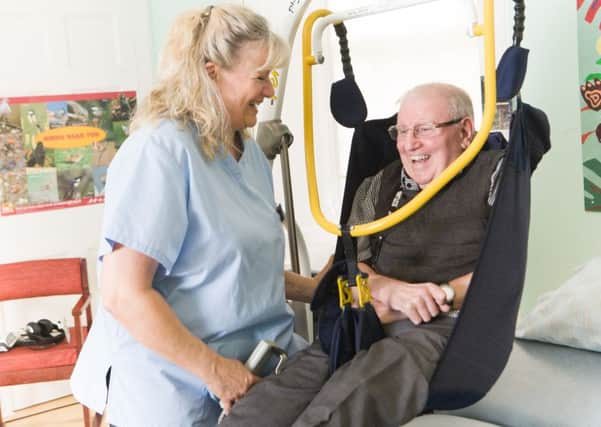Moni Robson: How to '˜normalise' life for wheelchair users


At Leuchie House we specialise in providing respite breaks for people and their families living with a range of neurological conditions such as multiple sclerosis and motor neurone disease. Due to the nature of their conditions, the majority of our guests are wheelchair users and rely on other people to help them with many routine tasks.
An important part of the service we offer is what has become known as “the Leuchie MOT”. This involves assessing our guests’ physical and emotional needs, providing practical support while they are at Leuchie and referrals to relevant community professionals for ongoing support as required.
Advertisement
Hide AdAdvertisement
Hide AdOur focus at Leuchie is on anticipatory and preventative interventions – a pro-active approach to tackling potential problems before they become an issue. As part of this we check that every guest’s wheelchair is suited to their individual needs, provides the support they require and is the right size for them. This is vital in preventing postural deterioration which can lead to complications like pressure ulcers, restricted breathing and digestive problems. Clearly, all of these impact greatly on quality of life and life expectancy, as well as being lengthy and costly to treat.
From our discussions with guests and from our own observations, we were becoming increasingly concerned that many didn’t have the kind of adjustable chair they needed to let them change position over the course of the day. This appeared to be exacerbated by having no one to help them get in and out of their wheelchair so they could use an armchair or recliner chair for periods of time.
To get a clearer picture of the extent of these issues, we decided to embark on a year-long survey involving all our wheelchair-using guests who were unable to get in and out of their chair without help. Over the course of 2015, we interviewed 100 people. We asked them all how long they typically spent in their wheelchair each day, whether they moved out of their wheelchair into another chair during the day, and if not why not.
NHS Scotland’s healthcare improvement body, Healthcare Improvement Scotland, currently recommends that anyone at high risk of developing pressure ulcers should not be seated for more than two hours without a change of position.
Among the group who took part in our survey, more than 70 per cent spend seven hours or more in their wheelchair, and 45 per cent spend 10 or more hours in their chair.
And 43 per cent do not move out of their wheelchair at all during the course of a typical day. The most commonly cited reasons were either because there was no one to help them move, or because they had no suitable alternative chair to move to.
The results of our survey reveal a worrying picture of daily life for a significant proportion of wheelchair users. They also suggest that this could be a much more widespread issue than we had originally anticipated. If, as we suspect, our group is representative of all the people in Scotland living with long term conditions, then there are potentially thousands of people in a similar situation, who stay in their wheelchairs for hours on end and are at risk of developing serious health complications.
There are various sides to the problem. Many over-stretched carers don’t have the time or the daily allocation of care visits to allow them to easily move the people they care for. For wheelchair users who do have someone to move them, it can be a difficult choice: retain your independence and ability to move around but spend the whole day in your wheelchair; or get help to change chair and be more comfortable initially but then be stuck in an armchair unable to get around until your carer returns several hours later.
Advertisement
Hide AdAdvertisement
Hide AdA lack of appropriate seating is also apparent. If a move to an alternative chair is not possible, a tilt-in-space wheelchair can help prevent pressure sores by temporarily shifting body weight from the rear to the back. Making these wheelchairs more widely available to those who need them could go some way towards alleviating the situation. Yet they don’t appear to fit within current prescription criteria. 65 per cent of the people we surveyed don’t have a chair that can be adjusted in this way.
This seems to be the root of the problem. Best practice guidelines recommend people at high risk should spend no more than two hours without a change of position. Yet many people in this category don’t have the level of care or the type of wheelchair they need to make this possible. If we can start a dialogue to address this discrepancy, the potential benefits could be enormous: improved health and wellbeing for people with long term conditions, a reduction in medical costs, and a health and social care system that is truly integrated.
Jim’s story:
I have motor neurone disease and have used a wheelchair for 14 years. I spend 12 hours in my wheelchair every day – from 9 in the morning until 9 at night. I live with my wife and have carers who come in to help with my personal care. They put me in my wheelchair after I’m showered and dressed in the morning and that’s me for the rest of the day. It takes two people to hoist me so my wife can’t do that on her own. When I stay at Leuchie House for a respite break, the care staff are able to transfer me to a recliner chair in the afternoon. This shifts the pressure and prevents pressure sores which are an ongoing issue for me. Having more carer time so that I could do this at home too would make a big difference.
• Moni Robson, lead physiotherapist at Leuchie House